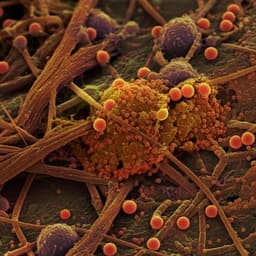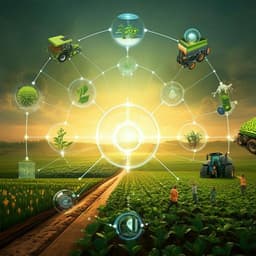
Environmental Studies and Forestry
Microspectroscopic visualization of how biochar lifts the soil organic carbon ceiling
Z. (. Weng, L. V. Zwieten, et al.
Discover how a second application of *Eucalyptus saligna* biochar has significantly raised the soil carbon storage ceiling in a subtropical pasture, while enhancing microbial efficiency and reducing SOC mineralization, research conducted by Zhe (Han) Weng and colleagues.
~3 min • Beginner • English
Introduction
Human activities risk releasing large amounts of ecosystem carbon (∼260 Pg C) as CO2. Agriculture is a major contributor to soil C losses, and conversion to tropical grasslands has depleted SOC substantially, particularly on Ferralsols. The study addresses how to reverse SOC loss by increasing retention and persistence of soil C. The IPCC recognizes soil C management and biochar amendment as carbon dioxide removal (CDR) strategies with co-benefits for soil health and productivity. While biochar is persistent and often reduces life-cycle GHG emissions, its capacity to protect and build new biogenic SOC through mineral and organic associations has been underappreciated. The research question is whether biochar can lift the SOC saturation ceiling in subtropical Ferralsols under pasture, and by what decadal-scale mechanisms—particularly via formation of organo-mineral and organo-organic interfaces in microaggregates and mineral fractions—that enhance SOC persistence by reducing mineralization and increasing microbial C-use efficiency.
Literature Review
The concept of SOC saturation posits an upper limit to SOC storage governed by protection mechanisms, notably mineral-associated organic matter. Prior work shows mineral protection regulates long-term preservation of organic C, with organo-mineral associations key to stabilization. Biochar is identified by IPCC as a promising CDR approach, with persistence and potential to deliver net climate benefits through reduced non-CO2 emissions. Previous studies have observed biochar-induced negative priming and accumulation of rhizodeposits in organo-mineral fractions, nanoscale organo-mineral reactions of biochar in ferralsols, and the role of microbial necromass in SOC. There is debate regarding mechanisms of SOC persistence (functional complexity, organo-mineral protection), and evidence that root exudates can both destabilize and stabilize mineral-associated C depending on context. This study builds on these works by providing direct micro- to nanoscale spectromicroscopic evidence linking biochar aging, organo-mineral coatings (Fe/Al-rich), and protection of rhizodeposits and microbial necromass over nearly a decade.
Methodology
Study system and treatments: A long-term field experiment at Wollongbar Primary Industries Institute, NSW, Australia (Rhodic Ferralsol: kaolinite-, gibbsite-, goethite-rich; topsoil pHCaCl2 4.5; 35 g C kg−1; 84 g Fe kg−1; 67 g Al kg−1). Established in 2006 with annual ryegrass under NPK fertilization. Treatments: Control (no biochar); Historical (single biochar application at establishment, 10 Mg ha−1, 7.6 Mg biochar-C ha−1 to 0–100 mm); At 8.2 years (2014), split plots received a second application at the same rate: Control+Recent (first biochar), Historical+Recent (second biochar). Field management otherwise identical across plots. Same biochar batch used in 2006 and 2014, from Eucalyptus saligna pyrolyzed at 550 °C for 30 min, <2 mm, density 0.332 g cm−3. Biochar mixed into 0–100 mm; for SOC stock comparisons soils sampled 0–75 mm (estimated 5.7 Mg biochar-C ha−1 present in top 75 mm). Sampling timeline: Soils sampled at 8.9, 9.2, and 9.5 years after establishment. Measurements included pH, total SOC by Dumas combustion with equivalent mass correction and bulk density conversion, microbial biomass C (MBC) by chloroform fumigation-extraction, and respiration components. Respiration measurements: Specialized collars isolated soil-only and soil+root respiration; root-only respiration measured in sand+root collars (with and without biochar). Moisture maintained to minimize isotopic fractionation. Rhizosphere priming and isotopic partitioning: Three 13C pulse-labelling campaigns (190 mg 13C m−2 each) on 12 Jun 2014, 01 Aug 2014, 30 Jul 2015. δ13C of CO2 from soil-only, soil+root, and sand+root measured at 3, 5, 10, 15 days post-labelling. δ13C of soils and fractions measured by IRMS; aged and new biochar δ13C both -25.0 ± 0.1‰. A three-pool partitioning model (biochar-C, root-C, native SOC) quantified SOC mineralization in presence/absence of roots and calculated rhizosphere priming. Sensitivity analyses explored endmember uncertainties (C3 vs C4 dominated contributions), propagating errors via first-order approximations. Aggregate size and density fractionation: Dry sieving yielded macroaggregates (250–2000 µm) and microaggregates (53–250 µm); density separation partitioned free-POM (p<1.6 kg m−3), occluded-POM (O-POM; >53 µm, p>1.6), and mineral-protected SOM (M-SOM; <53 µm, p>1.6). Recovery of 13C in pools calculated relative to added label. Microbial community activity: Catabolic enzyme activities (β-glucosidase, xylosidase, cellulase, N-acetyl-glucosaminidase, phosphatase) measured using fluorogenic substrates after 7-day incubation at 40% WHC. Specific enzyme activity calculated as enzyme activity normalized by MBC. Substrate-induced respiration profiled using MicroResp with 15 C substrates representing common soil and root exudates; hydrolysis blank subtracted. Spectromicroscopy and imaging: 3D FIB-SEM-EDS mapped elemental distributions (C, Si, Al, Fe) within intact aggregates (voxel 84×84×1000 nm). Nanoscale analyses of biochar particles by SEM/STEM, HAADF-STEM, EDS, and C-edge EELS to identify organo-mineral/organic coatings and functional groups. Synchrotron soft X-ray (SXR) spectroscopy (275–325 eV, 0.1 eV step; normalized and deconvolved) on microaggregates and mineral fractions, and on field-extracted biochars (1.3 y vs 9.5 y age). Synchrotron infrared microspectroscopy (IRM) on semi-thin (200 nm) sections of intact microaggregates and mineral fractions to map polysaccharide-C (1035 cm−1), aromatic-C (1600 cm−1), aliphatic-C (2920 cm−1), and clay-OH (3650 cm−1). Image processing pipelines (FIJI) normalized channels, segmented maps, and quantified pixel-wise co-localization and proportions; correlations between clay and C functional groups assessed by regression. LC-OCD measured DOC composition (biopolymers, persistent C, building blocks, low-MW acids, low-MW neutrals). Statistical considerations: Replicated plots (n=3); multiple lab replicates for spectral analyses (n=9 composites); LSD reported for SOC; confidence intervals for priming based on sensitivity analysis and mean squares normalization across treatments.
Key Findings
- SOC ceiling lifted by biochar: In 0–75 mm topsoil, Control stored 35 ± 1.3 Mg C ha−1 at 9.5 y; Historical (single biochar at establishment) stored 50 ± 1.1 Mg C ha−1. Control+Recent (first biochar at 8.2 y) reached 44 ± 0.7 Mg C ha−1 after 1.3 y; Historical+Recent (second biochar at 8.2 y) reached 58 ± 0.2 Mg C ha−1 after 1.3 y.
- Partitioning of increases: Historical gained 15 Mg C ha−1 over 9.5 y, comprising 5.7 Mg biochar-C ha−1 and 9.3 Mg new SOC ha−1. Historical+Recent over two applications gained 23 Mg C ha−1 (11.4 Mg biochar-C ha−1 + 11.6 Mg new SOC ha−1 ≈ 1.01 Mg new SOC per Mg biochar-C).
- Additional benefit of second application: Second biochar application added 2.3 Mg new C ha−1 relative to Historical (single application), a 25% increase in new SOC accumulation.
- Negative priming and reduced SOC mineralization: Historical+Recent lowered SOC mineralization in presence of roots by 89 g CO2-C m−2 over 1.3 y vs Control+Recent reduced by 55 g CO2-C m−2 (P<0.05). Overall, mineralization of native SOC decreased by ~18% in amended soils.
- Enhanced retention of rhizodeposits and microbial necromass: Belowground 14C retention (15 days post-labelling) in Historical+Recent and Historical was ~58–60% of total recovered label vs ~42–45% in Control and Control+Recent. Increased retention primarily in mineral-protected SOM (M-SOM); M-SOM-associated 13C increased by 14% in Historical+Recent vs Control+Recent. Early (8.9 y), 13C in O-POM (microaggregates) and M-SOM (macroaggregates) nearly doubled (5 and 14 mg C m−2, respectively) vs Control+Recent, later transforming into M-SOM.
- Microbial physiology: Microbial biomass was 8–12% higher in Control+Recent than Historical+Recent (8.9–9.5 y), indicating initial co-metabolic stimulation in previously unamended soil. Historical+Recent showed lower metabolic quotients (higher C-use efficiency) for bulk SOC; reduced specific enzyme activities contributed to negative priming. Substrate-induced respiration increased for carboxylic/phenolic acids in Historical+Recent.
- Spatially resolved evidence: 3D FIB-SEM-EDS within intact aggregates showed spatial co-location of C with Fe/Al minerals, consistent with organo-mineral protection. Nanoscale HAADF-STEM/EELS/EDS identified organo-mineral clusters rich in Al, Si, Ca, P, Fe on biochar surfaces and pores; coatings contained functional groups (C=C, C–OH, C–N/C=N, C=O, COOH, quinones). SXR of field-extracted biochars showed higher carboxyl COOH intensity in 9.5-y aged biochar (10.6%) vs 1.3-y (6.1%).
- Molecular signatures in soil fractions: SXR indicated microaggregates enriched in quinones, aromatic, aliphatic, and carboxylic C; mineral fractions dominated by aliphatic, amide, and carboxylic C (microbial metabolites, exopolysaccharides, root exudates). Aliphatic C proportion in mineral fraction nearly doubled in Historical+Recent (30.6%) vs Control+Recent (15.6%). IRM maps and image analysis showed higher aromatic-C in microaggregates of Historical+Recent (31% pixels) vs Control+Recent (22%) and strong co-localization of aliphatic-C and polysaccharide-C with clay (R2 up to 0.96 and 0.83, respectively).
- DOC composition: LC-OCD showed higher total DOC, hydrophobic C, and building blocks (oxidized persistent C, polyaromatic acids, polyphenols) in Historical+Recent vs Control+Recent.
- Global extrapolation: With 0.48–0.90 Pg C y−1 of potential woody feedstock for biochar and assuming ~1.01 Mg new SOC per Mg biochar-C over two applications on Ferralsols under tropical pasture, an additional soil C sink of 0.23–0.45 Pg C y−1 could be realized, beyond current grassland contributions (~0.04 Pg C y−1).
Discussion
The study demonstrates that biochar can lift the SOC saturation ceiling in a subtropical Ferralsol by promoting the retention of new biogenic carbon (rhizodeposits and microbial necromass) and by reducing native SOC mineralization (negative priming). Mechanistically, biochar surfaces accumulate organo-mineral and organo-organic coatings over time, mediated by interactions with variable-charge Fe/Al oxides and cation-bridged sorption of low-molecular-weight organic compounds. These coatings embed rhizodeposits and microbial residues, protecting them from microbial access and enzymatic attack at nano- to micro-scales. Multi-modal spectromicroscopy (3D FIB-SEM-EDS, HAADF-STEM/EELS/EDS, SXR, IRM) provides direct spatial and chemical evidence for these interfaces both on biochar and within aggregates. Increased microbial C-use efficiency and lowered specific enzyme activity further reduce turnover of bulk SOC, aiding negative priming without suppressing total respiration or root respiration fractions. The temporal progression observed—initial retention in O-POM and M-SOM of larger aggregates followed by transfer into mineral-associated SOM—aligns with established pathways of SOM stabilization. The second biochar application created new sorptive surfaces and pores, enhancing these processes and delivering an additional 2.3 Mg new C ha−1, indicating that strategic reapplications can continue to raise SOC ceilings. At scale, such mechanisms could substantially augment CDR potential in (sub)tropical grasslands, particularly on Ferralsols, while also improving soil health through aggregation and nutrient interactions.
Conclusion
This work provides decadal-scale, micro- to nanoscale evidence that biochar raises the SOC storage ceiling by stabilizing rhizodeposits and microbial necromass via organo-mineral and organo-organic interfaces within microaggregates and mineral fractions. A single biochar application yielded 9.3 Mg new C ha−1 and a second application added a further 2.3 Mg new C ha−1, with total SOC gains of 23 Mg C ha−1 over 9.5 years in the top 0–75 mm. Negative priming, increased microbial C-use efficiency, and enhanced mineral association underpin these gains. If replicated across suitable Ferralsols in (sub)tropical grasslands with sufficient woody feedstock for biochar, global CDR of 0.23–0.45 Pg C y−1 is plausible. Future research should assess generalizability across soil types, climates, biochar feedstocks and pyrolysis conditions, optimize reapplication schedules, quantify deeper soil profiles and whole-soil carbon balances, and evaluate long-term ecosystem and agronomic outcomes, including nutrient cycling and biodiversity impacts.
Limitations
- Site and soil specificity: Findings are from a single Ferralsol under subtropical pasture; responses may differ in other soils, climates, vegetation, and management systems.
- Biochar type and rate: One biochar feedstock (Eucalyptus saligna) and production condition (550 °C) at a single rate (10 Mg ha−1) were tested; other biochars and rates may alter mechanisms and magnitudes.
- Sampling depth: SOC stocks were quantified to 0–75 mm while biochar was incorporated to 0–100 mm, potentially underestimating new SOC accumulation and biochar-C distribution in the full incorporation depth.
- Temporal scope of reapplication: Post-second application observations span 1.3 years; longer-term trajectories after reapplication remain to be characterized.
- Replication and variance: Field replication was limited (n=3); some inferences rely on spectroscopic proxies and image-based correlations requiring cautious interpretation.
- Enzyme assay artifacts: Although matrix-matched standards were used, potential sorption or quenching effects of fluorophores/enzymes on biochar surfaces could bias enzyme activity estimates.
- Isotopic partitioning assumptions: Sensitivity analyses addressed endmember uncertainty (C3 vs C4), but partitioning models still carry assumptions that influence priming estimates.
- Global extrapolation: Scaling assumes similar responses on Ferralsols globally and sufficient sustainable feedstock; real-world variability and sustainability constraints may limit achievable CDR.
Related Publications
Explore these studies to deepen your understanding of the subject.







